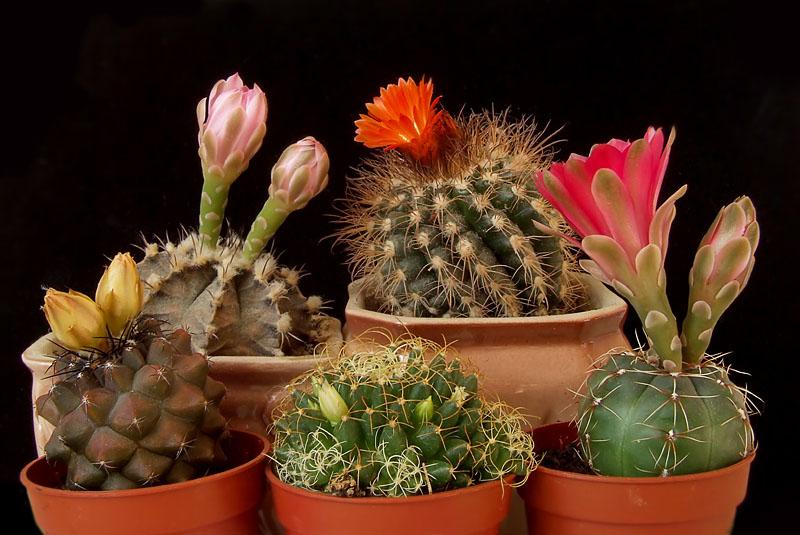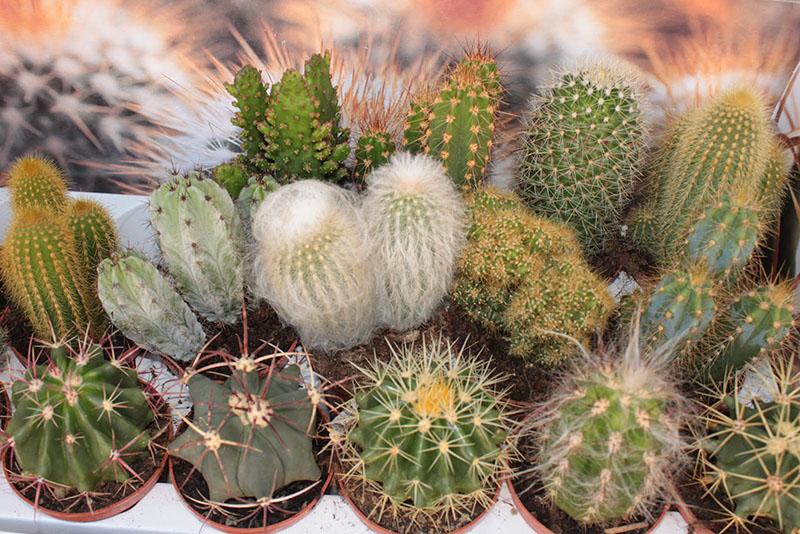How to care for a cactus so that it delights you with its flowering
 Breeding cacti at home is a hobby that fascinates the whole person. This activity satisfies his aesthetic needs and allows him to fully reveal his love for nature. It is important to know how to care for a cactus in order to grow a beautiful, noteworthy specimen. Breeding cacti expands the horizons and circle of acquaintances by interests, makes it possible to rejoice at your successes and show them to others. A storm of delight and positive emotions is reaped by the owner of cacti, rewarded for his work with the lush and abundant flowering of his favorites!
Breeding cacti at home is a hobby that fascinates the whole person. This activity satisfies his aesthetic needs and allows him to fully reveal his love for nature. It is important to know how to care for a cactus in order to grow a beautiful, noteworthy specimen. Breeding cacti expands the horizons and circle of acquaintances by interests, makes it possible to rejoice at your successes and show them to others. A storm of delight and positive emotions is reaped by the owner of cacti, rewarded for his work with the lush and abundant flowering of his favorites!
A person who is engaged in what he loves is much less prone to melancholy and depression.

Distinctive features of cacti
 The variety of cactus species is very large, depending on the area of their origin, they require certain conditions for normal growth, development and flowering. Different types of cacti are very different from each other in appearance. Among them there are giants - reaching 18-20 meters in height, there are kids - only one and a half centimeters high and three wide. There are cacti, round and covered with thorns, there are spreading ones with real leaves.
The variety of cactus species is very large, depending on the area of their origin, they require certain conditions for normal growth, development and flowering. Different types of cacti are very different from each other in appearance. Among them there are giants - reaching 18-20 meters in height, there are kids - only one and a half centimeters high and three wide. There are cacti, round and covered with thorns, there are spreading ones with real leaves.
But all of them are united by signs of family similarity. To be called a cactus, a plant must have the following botanical characteristics:
- be perennial succulent - a plant capable of storing moisture in tissues;
- belong to dicotyledonous plants, their seeds and seedlings have two cotyledons;
- the presence of an areola is mandatory - an active zone where the rudiments of thorns and flowers and a new growth are located;
- the ovary of the fruit should be lower - the fruit develops under the flower;
- the fruit is a berry.
How to care for a cactus
 There is an opinion among cactus lovers that the more attention you pay to your cacti, the more often you look at them, the better they grow. In fact, there is no magic in this, carefully examining and observing cacti, you can easily notice signs of disease, pest damage and other changes. Changes in color, growth, shape of a cactus can indicate a lack or excess of vital factors: water, light, temperature.
There is an opinion among cactus lovers that the more attention you pay to your cacti, the more often you look at them, the better they grow. In fact, there is no magic in this, carefully examining and observing cacti, you can easily notice signs of disease, pest damage and other changes. Changes in color, growth, shape of a cactus can indicate a lack or excess of vital factors: water, light, temperature.
By looking at cacti often, it is easy to notice developmental defects or signs of disease, and by changing care factors or procedures, prevent unwanted consequences.
When growing cacti at home, it is necessary to take into account many important points: soil composition, pot size, degree of illumination, air temperature and humidity, frequency and abundance of watering.
Soil composition for cacti
 The main sign of a good soil for cacti is coarse-grained and loose. These criteria must ensure good water and air flow capacity.A mixture of leaf humus, clay lumps, coarse sand and charcoal has proven itself well. Humus contains the available nutrients necessary for the growth of a cactus.
The main sign of a good soil for cacti is coarse-grained and loose. These criteria must ensure good water and air flow capacity.A mixture of leaf humus, clay lumps, coarse sand and charcoal has proven itself well. Humus contains the available nutrients necessary for the growth of a cactus.
 Clay lumps trap and retain moisture and support the roots of large, tall cacti. Coarse sand is used to create a loose and porous structure. Charcoal promotes looseness of the soil and releases substances that suppress the development of rot.
Clay lumps trap and retain moisture and support the roots of large, tall cacti. Coarse sand is used to create a loose and porous structure. Charcoal promotes looseness of the soil and releases substances that suppress the development of rot.
Pot size
 The size of the cactus pot depends on the size of its root system. The roots of the cactus should fit freely in the pot, without bending at the ends.
The size of the cactus pot depends on the size of its root system. The roots of the cactus should fit freely in the pot, without bending at the ends.
 For cacti with a developed root system, tall, elongated containers are better suited.
For cacti with a developed root system, tall, elongated containers are better suited.
 Cacti with wide roots will do well in wide, shallow pots. When preparing pots for transplantation, you need to disinfect them with alcohol to prevent re-infection with diseases.
Cacti with wide roots will do well in wide, shallow pots. When preparing pots for transplantation, you need to disinfect them with alcohol to prevent re-infection with diseases.
How to care for a cactus, observing the light regime

Cacti are light-loving plants, so the more light the better. In order for the cactus to receive the maximum amount of light, you need to place it on the window. At the same time, pay attention to the cleanliness of the glasses, dusty glasses trap more light than we think - up to 40%! In doing so, you need to understand the difference between light and direct sunlight. In their homeland, cacti are all year round under the scorching rays of the sun and do not suffer from burns.
 Our cacti, hibernating in an apartment, weaned from exposure to sunlight during this time, need to be gradually accustomed to ultraviolet light.
Our cacti, hibernating in an apartment, weaned from exposure to sunlight during this time, need to be gradually accustomed to ultraviolet light.
When exposing cacti to the open air in spring, it is best to block them from direct sunlight with a homemade trellis.
 It can be made from 1 cm wide strips of cardboard. This lattice creates a “moving shadow” effect and protects cacti from burns. To understand if the sun's rays can harm a cactus, you need to know where this species comes from. Cacti from mountainous and lowland areas tolerate sunlight well. In contrast, the natives of the rainforest prefer partial shade and do not tolerate excessive sun exposure.
It can be made from 1 cm wide strips of cardboard. This lattice creates a “moving shadow” effect and protects cacti from burns. To understand if the sun's rays can harm a cactus, you need to know where this species comes from. Cacti from mountainous and lowland areas tolerate sunlight well. In contrast, the natives of the rainforest prefer partial shade and do not tolerate excessive sun exposure.

Sun-loving cacti are contraindicated in direct sunlight in summer if:
- plants are not used to sunlight after wintering;
- the plant is sick;
- the plant has just been transplanted.
In these cases, gradual addiction is recommended, and in the case of a disease, a course of treatment must first be carried out.
Temperature and humidity
 Cacti from mountainous areas - pillar-shaped oreocereus, globular lobivia and dwarf rebutia cacti, usually do not require a special temperature regime, except for the "winter regime". The exception is cacti originating from tropical forests - ripsalis, zygocactus, epiphyllums. Lowering the temperature in winter is contraindicated for them; they grow best in greenhouse conditions, in warm and humid air.
Cacti from mountainous areas - pillar-shaped oreocereus, globular lobivia and dwarf rebutia cacti, usually do not require a special temperature regime, except for the "winter regime". The exception is cacti originating from tropical forests - ripsalis, zygocactus, epiphyllums. Lowering the temperature in winter is contraindicated for them; they grow best in greenhouse conditions, in warm and humid air.
Watering mode
 The amount and frequency of watering directly depends on the type and size of the cactus, the growing season and air temperature. Large, moisture-loving cacti with well-developed root systems require frequent watering and more water in hot weather. Dry-loving cacti in a state of winter dormancy, at low air temperatures, can do with occasional watering with a small amount of water.
The amount and frequency of watering directly depends on the type and size of the cactus, the growing season and air temperature. Large, moisture-loving cacti with well-developed root systems require frequent watering and more water in hot weather. Dry-loving cacti in a state of winter dormancy, at low air temperatures, can do with occasional watering with a small amount of water.
 An experienced cactus grower, taking into account all these factors and using the results of observing his pets, finds an individual watering regime for each cactus.
An experienced cactus grower, taking into account all these factors and using the results of observing his pets, finds an individual watering regime for each cactus.
How to properly transplant
 It is best to replant cacti in the spring, when they have not yet begun to grow.
It is best to replant cacti in the spring, when they have not yet begun to grow.
The transplant instruction contains several main stages:
- preparation of soil and pots;
- preparation of cacti;
- transfer;
- care and supervision of transplanted plants.
Preparing cacti for transplanting
 The preparation of cacti includes carefully removing them from the pots, inspection, cleaning the roots from old soil and dead roots, and, if necessary, a root bath.
The preparation of cacti includes carefully removing them from the pots, inspection, cleaning the roots from old soil and dead roots, and, if necessary, a root bath.
When removing from an old pot, wrap the cactus with a napkin and, turning the pot over, gently shake it out.
This will not be difficult if the soil has been mixed in the correct ratio and has not lost its looseness. The most important thing is not to damage the roots, minor damage can lead to rotting of the entire root system and the death of the cactus. If the soil is packed in a dense lump, and there is no way to easily release the roots, you need to lower it in a container with warm water until it is completely softened. After that, you need to rinse the roots with clean water and dry for 12-24 hours, hanging the cactus. To do this, wrap the cactus stalk with a wide strip of cloth so as not to cause damage.
Having cleared the roots of the old earth, you need to carefully examine them for damage, rotted and dead areas. Damage must be treated with alcohol and dried. Dead and decayed areas are removed with scissors treated with alcohol. A hot root bath is a pest control agent. It can also be a good incentive for healthy but lazy cacti. Such cacti have good roots, a healthy look, but they are in no hurry to get under way. After a root bath, most of them begin to grow actively.
The optimum water temperature for the root bath is 50-55 ° C, the cactus should be fixed over the container so that only the roots are in the water. The bath lasts 15 minutes, after which the cactus is hung to dry.
Cactus transplant
 Drainage from small pebbles or pieces of charcoal is laid out in the pots for transplantation, at the bottom. If you have soft water, it is recommended to add a little crushed plaster as a source of calcium.
Drainage from small pebbles or pieces of charcoal is laid out in the pots for transplantation, at the bottom. If you have soft water, it is recommended to add a little crushed plaster as a source of calcium.  The cactus must be lowered into the pot so that the roots do not touch the bottom, and gradually fill the space with earth.
The cactus must be lowered into the pot so that the roots do not touch the bottom, and gradually fill the space with earth.  The earth can be compacted by tapping the pot on the table.
The earth can be compacted by tapping the pot on the table.
After transplanting, do not water the cacti for a week to dry and heal microscopic lesions, otherwise root rot may develop.
After transplanting, cacti need a special regime in order to avoid a critical loss of moisture, it is necessary to create greenhouse conditions. At home, it is enough to cover the cactus with a plastic bag. Transplanted cacti should be placed in the shade. In hot weather, you can spray the plants with warm water from a spray bottle once, and cover them again with foil. In the first month after transplanting, cacti need rest. It is not necessary to rearrange them from place to place, so as not to change the illumination mode.
How to care for a cactus to bloom
 Blooming cactus is considered a rarity. Indeed, most often blooming cacti can be seen in a flower shop. There is even a legend that some cacti bloom once in a lifetime and then die.
Blooming cactus is considered a rarity. Indeed, most often blooming cacti can be seen in a flower shop. There is even a legend that some cacti bloom once in a lifetime and then die.
 The main factor affecting the flowering of a cactus is the temperature regime. For unpretentious cacti, a change in day and night temperatures is enough if they remain outdoors in the summer season.
The main factor affecting the flowering of a cactus is the temperature regime. For unpretentious cacti, a change in day and night temperatures is enough if they remain outdoors in the summer season.  The temperature difference can cause flowering even in cacti that have not been in winter mode. These include Mammillaria, whose small flowers frame the top of the cactus like a wreath. The temperature difference is especially important in autumn when the nights get colder. This hardens the cactus, thickens the epidermis and prepares it for wintering.
The temperature difference can cause flowering even in cacti that have not been in winter mode. These include Mammillaria, whose small flowers frame the top of the cactus like a wreath. The temperature difference is especially important in autumn when the nights get colder. This hardens the cactus, thickens the epidermis and prepares it for wintering.
In winter, a cactus needs a wintering regime:
- Ideally, this can be a dry, unheated room. In it, the temperature does not drop below + 10 ° C, and there is a source of daylight - a window.
- Watering in winter is rarely done. Once every 1-2 weeks, two to three tablespoons of water, depending on the size of the pot.
- Low winter temperatures, reduced watering, and an indispensable source of daylight are the keys to abundant and lush blooming of cacti.
To bloom, a cactus must be in a growing state.
If it is not possible to rearrange the cactus for the winter in a cold room, but you really want it to bloom, you can fence off the cactus on the windowsill from the warm room air. To do this, you can use something like an aquarium, which faces the open side of the window glass.
 Carried away by the cultivation of cacti, a person develops in many directions at once. He deepens his knowledge in the fields of botany, soil science and plant growing. He is interested in the geographical origin of his plants, begins to understand the Latin names. Getting to know other cactus growers expands social bonds and develops communication skills. To paraphrase the classic, we can say with confidence: breeding cacti is a path, not a goal.
Carried away by the cultivation of cacti, a person develops in many directions at once. He deepens his knowledge in the fields of botany, soil science and plant growing. He is interested in the geographical origin of his plants, begins to understand the Latin names. Getting to know other cactus growers expands social bonds and develops communication skills. To paraphrase the classic, we can say with confidence: breeding cacti is a path, not a goal.